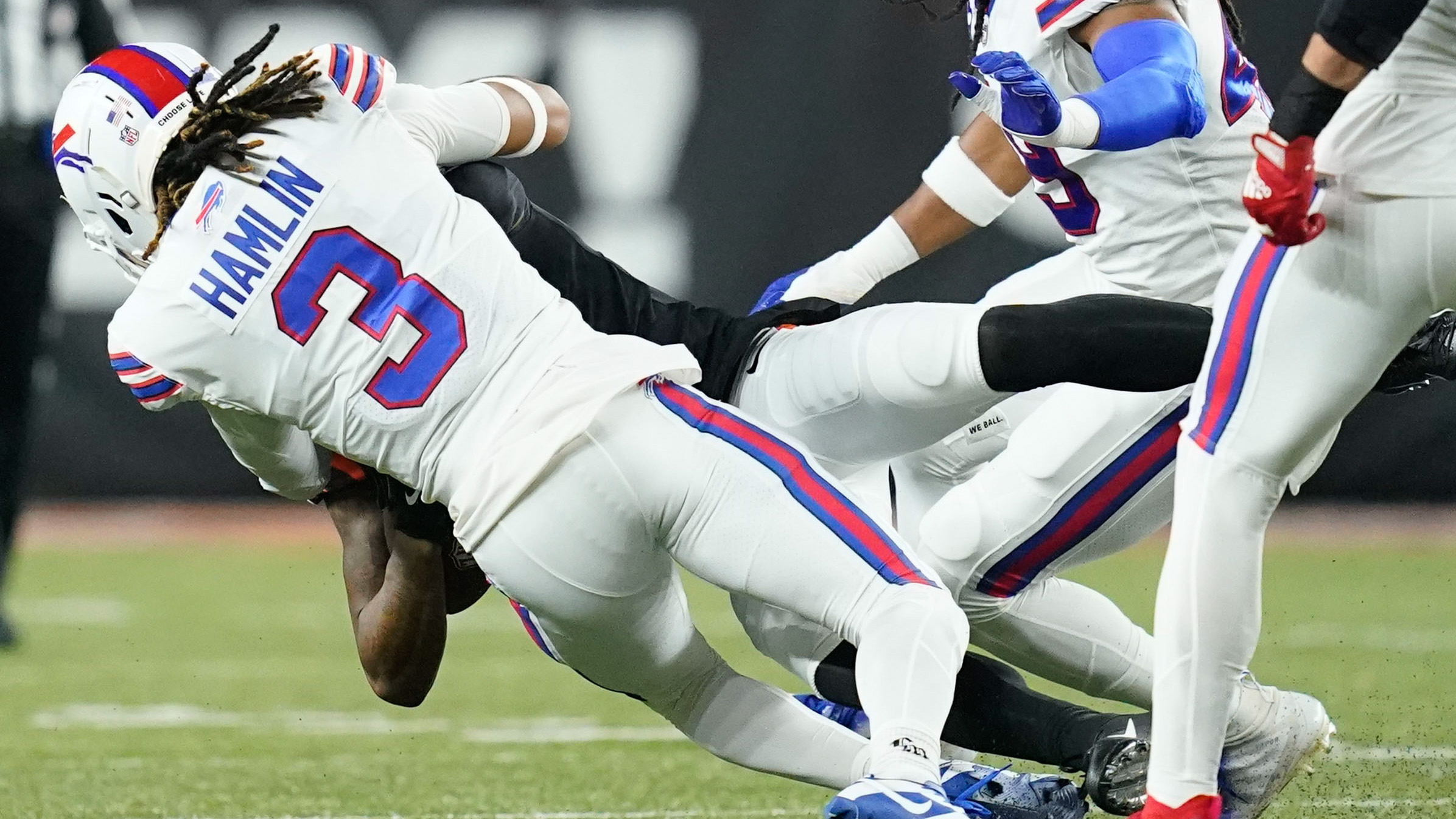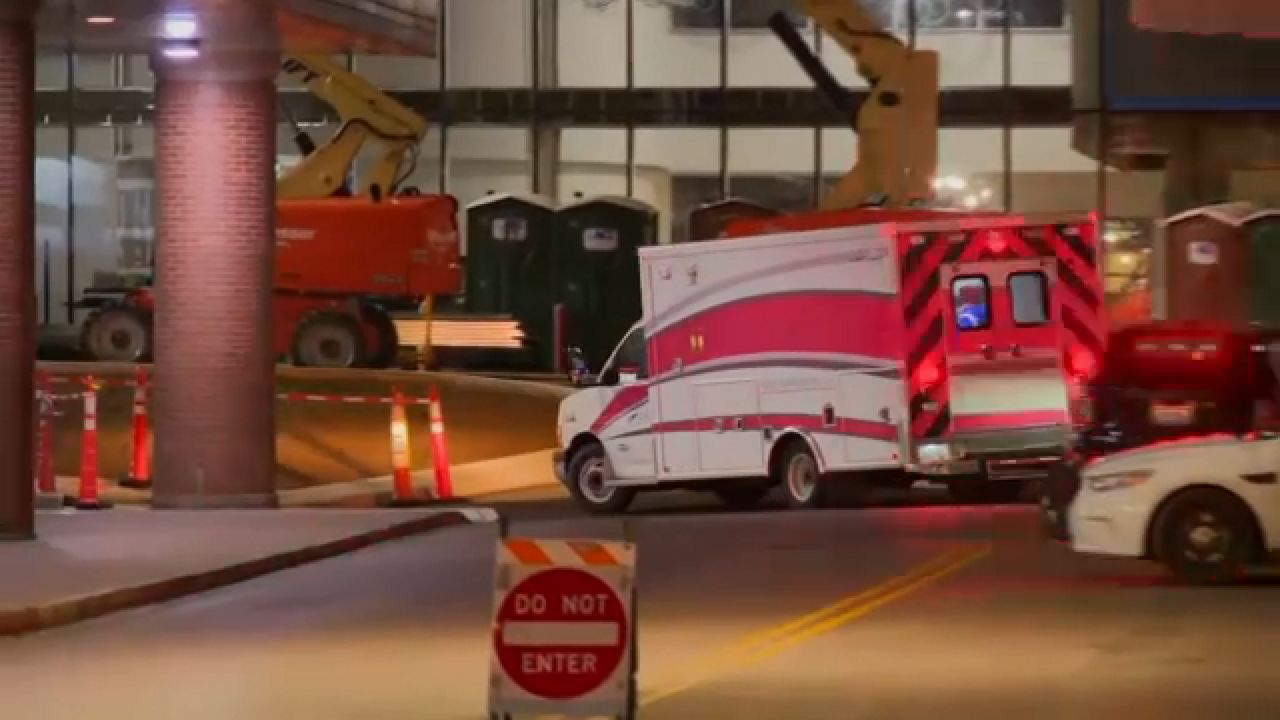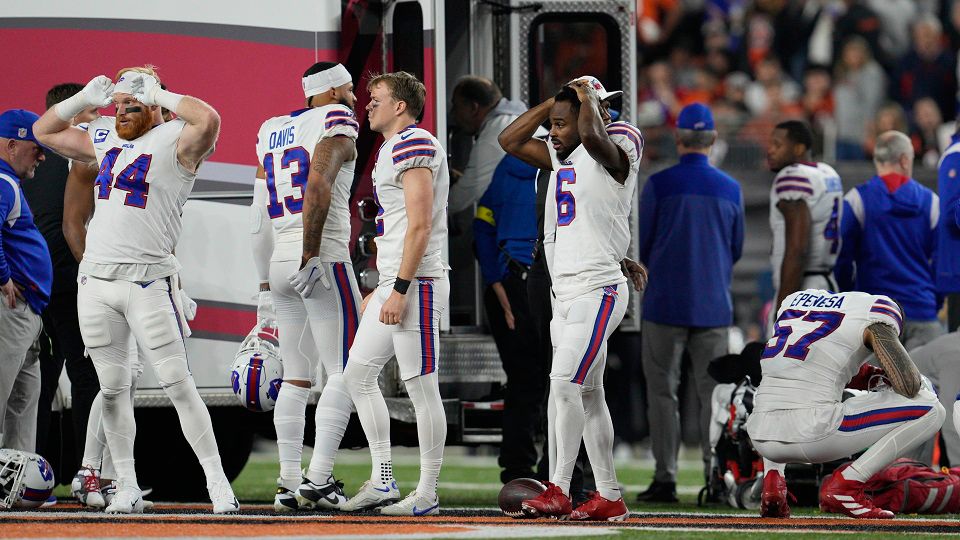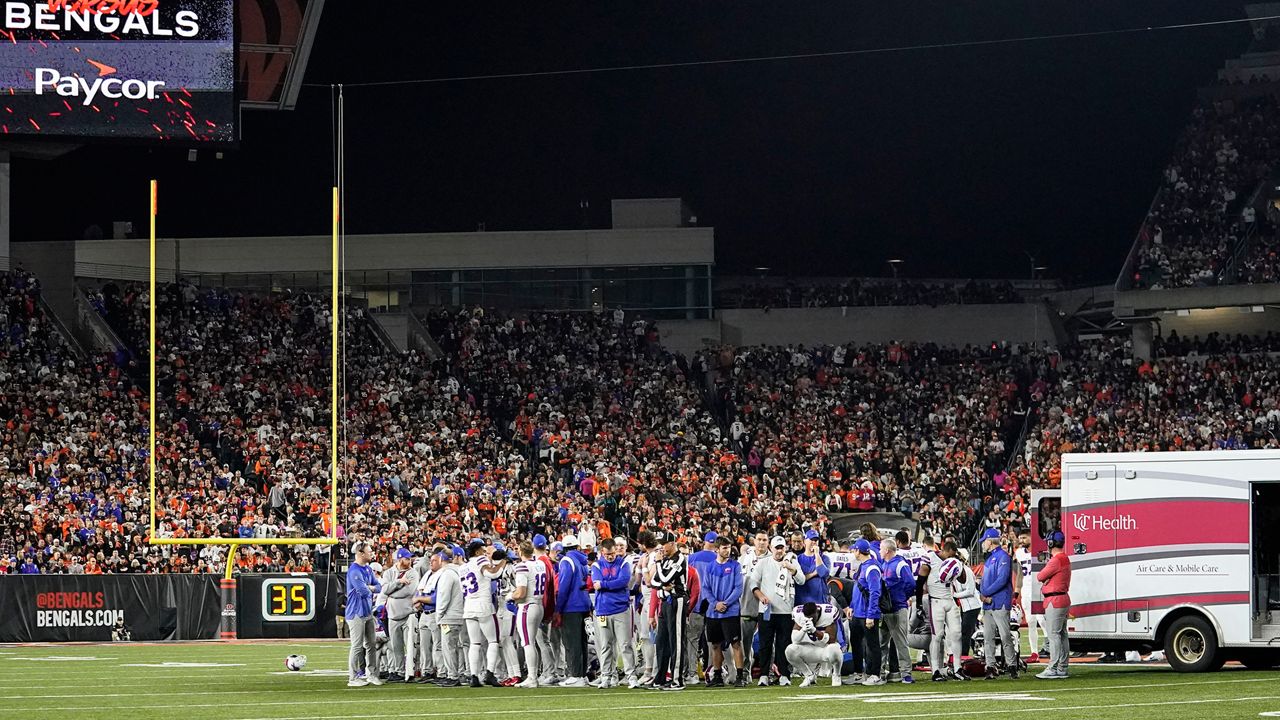CINCINNATI — Dr. Kristen Kent spent parts of her 19 years in emergency medicine serving as a physician at sporting events like Cincinnati Reds games. But she never had a player suffer an on-field incident similar to what happened to Buffalo Bills defensive back Damar Hamlin on Monday night.
What You Need To Know
- Medical personnel rushed onto the field on Monday to provide emergency aid to Bills player Damar Hamlin who suffered cardiac arrest
- Hamlin's family praised emergency medical personnel for their response and treatment
- NFL games and other sporting events feature game-day medical crews consisting of doctors, athletic trainers and medics to assist players and fans in these types of situations
- The medical teams develop emergency plans and prepare to use them all season
During the first quarter of the Cincinnati Bengals-Buffalo Bills matchup at Paycor Stadium, Hamlin collapsed after tackling wide receiver Tee Higgins on a routine play.
The Bills would later confirm that Hamlin, 24, suffered cardiac arrest on the field.
Medical personnel performed treatment, including administering CPR, applying portable defibrillator paddles (AED) and giving him oxygen, on the field for nearly 20 minutes, ESPN reported. They then transported Hamlin by ambulance to the University of Cincinnati Medical Center, the region’s only level one trauma center.
“His heart stopped,” Kent said of the incident. “For a fit, young athlete, something like that happening is highly rare.”

Kent, who now practices medicine in New Jersey, didn’t see the play live, but while watching the replay, she saw a “basic tackle to his chest and he stood up and then he went down like he had no muscle tone,” she said.
While Kent hadn’t seen Hamlin’s medical charts, she described what she’s heard of Hamlin’s condition as similar to what’s known as commotio cordis. It’s the result of blunt trauma to the chest, which causes the person to develop an irregular heart rhythm. It often leads to sudden death, according to the National Library of Medicine.
“It’s normal for people to have chest injuries and even cardiac injuries from blunt trauma, but to actually have your heart stop beating, that is extremely rare.”
While Kent has never experienced an athlete suffering cardiac arrest, it happens.
For example, Danish soccer player Christian Eriksen suffered cardiac arrest on the pitch midway through a 2021 European tournament match. Medics resuscitated him on the field, per CNN. Eriksen made his return to competitive soccer less than a year later.
More tragically, in 1971, Detroit Lions wide receiver Chuck Hughes had a fatal heart attack, according to Time. The report states that the teams did not suspend the game but instead played the final minute as medics tried to save Hughes.
The Hamlin incident may remind some Cincinnatians and sports fans of the death of veteran umpire John McSherry on opening day in 1997. He was behind home plate for the game between the Cincinnati Reds and Montreal Expos at Riverfront Stadium.
McSherry called timeout and then collapsed while walking toward a gate behind the plate. Paramedics and trainers from both teams administered CPR, but McSherry never regained consciousness, Los Angeles Times reported.
Doctors pronounced McSherry dead at UC Medical Center. A hospital spokesperson said he died of “sudden cardiac death,” in which the heart beats out of control, per the Times report.
As of Wednesday, Hamlin remained in the intensive care unit with signs of improvement noted Tuesday and overnight, the Bills franchise said. Hamlin's family reported him only relying on 50% breathing support from a ventilator, as opposed to 100% when he was first admitted, according to spokesperson Jordon Rooney. He told the Associated Press that Hamlin’s family and friends “remained optimistic,” but stressed he couldn’t go into further detail on the Bills’ player’s health status.
Earlier in the day Tuesday, Hamlin’s family issued a statement praising the first responders and health care professionals who’ve provided “exceptional care for Damar.”
“These are such rare events and usually, there’s no way anyone could have predicted them. And that’s emergency physicians, paramedics — that entire team, that’s why we’re there,” Kent said. “We take care of things that aren’t predictable, and through our training, we’re able to manage them well and efficiently, because that’s what we do every day, whether it’s on a playing field or not.”
Just another 'Tuesday afternoon at the office'
Kent refers to emergency medicine as the first line of defense in new and potentially fatal conditions.
“Some people explain it as the first hour of any severe disease or any life-threatening or urgent medical problems,” she said. Medical issues could range from traumatic brain injury, strokes and heart attacks to suicide and drug overdoses.
Kent described working on critical injuries as a “Tuesday afternoon at the office” for those in emergency medicine.
“It’s rare for a young athlete, pro football player to have a cardiac arrest on the field, but to have somebody experience a life-threatening health situation, isn’t,” she said. “This is our normal day to day, and that’s why we’re there.”
While in Cincinnati, Kent worked at several major events — tennis and golf tournaments, and offered support for the Reds and the Xavier University basketball program.
She also worked a Bengals’ home playoff game a few years ago.
In her role, she not only provided on-field support but also treated fans who may suffer injuries, whether it’s a heart attack or heat stroke.
Most athletic programs have two different medical teams, Kent said. There’s a sports medicine team, featuring a specialist in orthopedics or sports medicine. It also includes an athletic trainer and physical therapists most of the time, Kent said.
But for games and major events, the size of that team grows considerably, Kent added. Sometimes it’s just a paramedic or an EMT and a nurse, while other times it’s all of them plus a physician.

Athletic trainer Tim Murray is part of the support team for the Cincinnati Cyclones, a minor-league hockey team.
The 35 year old has been working in the field for almost 14 years. Beyond hockey, he’s also worked in professional baseball and covered a variety of sports at the high school level in Northern Kentucky.
“I tell people all the time: on a good day, I’m hanging out and handing out towels and water bottles,” he said. “If that’s all I’m doing, that means guys are good and healthy. But in a situation like Monday night, I’d be the first person out there and making sure my guy’s in the best position to receive the care he needs.”
While he hasn’t had to perform CPR on a player, he’s dealt with other traumatic injuries. While he was an athletic trainer for the former Florence Freedom baseball team in 2019, he had a player break bones in his neck.
The player got caught in a rundown, and while trying to slide into home plate, his helmet got caught in the turf and left his neck in a full flex position, Murray said. The catcher inadvertently kneeled on the back of the player’s neck.
Murray said he was out of the dugout and to him less than 20 seconds later. But time felt to him like it stood still and his training kicked in, he said.
“You could just see his body go limp,” Murray said. “He told me he couldn’t feel his legs, and his arms were tingling.”
The results of his neurological screening “weren’t good,” he added.
“I worked with the medics and got him in a cervical collar to stabilize and immobilize his neck, got him on the stretcher and sent him off the hospital,” Murray said, noting that he’d have surgery soon after that.
In part because of a speedy response, the player, who Murray chose not to identify by name, made a return to professional baseball for a couple more seasons.
“I can guarantee you that the medical team (at the Bengals game on Monday) were already heading toward that player before anybody else even noticed what had happened,” he added.
Preparing for the unimaginable
Regardless of the sport, teams create Emergency Action Plans, or EAPs, at the start of every season to prepare for seemingly unthinkable crisis situations, such as the one during the Bengals-Bills game, Murray said. Those plans outline exactly where one medical provider’s role stops and another takes over.
“The goal is to make sure you know it like the back of your hand, so if something happens, your training just sort of kicks in,” Murray said.
When an athlete is injured, what typically happens is the athletic trainer is the first on the playing surface, Murray said. They’ll then signal to the emergency team — the paramedics, nurses and the physician — for serious issues like a neck injury or a life-threatening emergency.
The Cyclones have a first responder set up for games and practices.
It’s Murray’s job to “get the ball rolling” for any injury to determine next steps, he said.

“Those guys (doctors, medics) don’t move unless I tell them to move, but they’re standing ready to go on my signal,” he said. “I get out there and assess what’s going on. If I think we need to get them off the ice, those guys are ready to move and do their jobs right away.”
Dr. Randy Marriott, medical director for the Premier Health EMS Center of Excellence in Dayton, said that on-field response can be critical in these types of life-and-death situations, especially as it relates to issues such as cardiac arrest.
Every minute that goes by without a shock being delivered lowers the chances of survival by roughly 10%, he said.
“If someone may not get to that individual with a defibrillator for 30 minutes, even with good CPR, the chances of their survival are extremely low,” Marriott said.
Marriott had kind words for the athletic trainers who attended to Hamlin on the field.
“It appears they did a tremendous job of an initial assessment and knowing that this was a cardiac problem that required him to receive immediate resuscitation,” he added.
There’s a misconception that athletic trainers are simply the people who “tape your ankles,” said Marriott, who formerly served as the sideline doctor for his son’s football team.
“These are highly trained individuals who know how to identify some key emergencies that might go under the radar of other providers,” he said. He noted things like acute heat strokes and concussion injuries.
While there are plans in place and protocols, when a situation like Monday night’s happening, “your instincts kick in,” Kent said.
“In those situations where someone isn’t breathing or doesn’t have a pulse, it’s no longer sports medicine,” she added. “You’re there to save their life just like you would in a hospital. It’s not different no matter the environment.”



